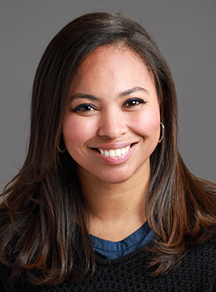Diana Rigueur
 Anatomy Scholar Dr. Diana Rigueur is a Distinguished Faculty at the University of California, Los Angeles (UCLA). She is a Molecular, Cell, and Developmental biologist who specializes in musculoskeletal and craniofacial research. She aspires to develop a better understanding of how the skeleton and nervous system are intimately linked during development and disease. Her overarching goal is to build a body of work that will inform on the development, maintenance, remodeling, and regeneration of the skeleton, while using this knowledge to inspire translational development of targeted treatments for skeletal disorders. Her first goal involved becoming a strong Lecturing Faculty in course curriculum design, while her next advancement includes developing and establishing a strong science programme in her future laboratory, investigating the regeneration of fibrous and cartilaginous joints in the craniofacial complex, as well as understanding how the meninges, a supporting central and peripheral nervous system tissue, regulates skeletal development, maintenance, regeneration, and disease in the axial skeleton.
Anatomy Scholar Dr. Diana Rigueur is a Distinguished Faculty at the University of California, Los Angeles (UCLA). She is a Molecular, Cell, and Developmental biologist who specializes in musculoskeletal and craniofacial research. She aspires to develop a better understanding of how the skeleton and nervous system are intimately linked during development and disease. Her overarching goal is to build a body of work that will inform on the development, maintenance, remodeling, and regeneration of the skeleton, while using this knowledge to inspire translational development of targeted treatments for skeletal disorders. Her first goal involved becoming a strong Lecturing Faculty in course curriculum design, while her next advancement includes developing and establishing a strong science programme in her future laboratory, investigating the regeneration of fibrous and cartilaginous joints in the craniofacial complex, as well as understanding how the meninges, a supporting central and peripheral nervous system tissue, regulates skeletal development, maintenance, regeneration, and disease in the axial skeleton.
During her PhD training at the University of California, Los Angeles (UCLA), Diana studied the role of Bone Morphogenetic Protein (BMP) signaling during the formation of the axial and appendicular skeleton, under the mentorship of world-renowned scientist, Dr. Karen M. Lyons. Her first project challenged the paradigm that Smad-4, a co-transcription factor, was required for receptor-regulated Smads-1/5/8 to drive transcription of BMP-targeted genes in cartilage. Her other projects included understanding the individual and overlapping roles of BMP Type I receptors (BMPR1A, BMPR1B, and ACVR1/ALK2) in the formation of the axial skeleton. Although the ALK2 receptor was infamously recognized by its gain-of-function mutations that cause the devastating skeletal disorder Fibrodysplasia Ossificans Progressiva, a disease characterized by sequential ossification of soft tissue organs, for which there is no cure, had not been characterized in skeletal development. Dr. Rigueur’s work showed that ALK2 held overlapping functions with BMPR1-A and -B in the formation of the spine and phalangeal ossification, but that loss of ALK2 caused progressive kyphosis, clearly demonstrating its independent requirement in spine development and maintenance.
During her postdoctoral years at the University of Southern California (USC), Dr. Rigueur built on her training in bone biology and specialized in craniofacial research, understanding the formation of neural crest and mesoderm-derived tissues in the laboratory of Dr. Amy Merrill. Her most significant contribution to date has been with Lacrimo-Auriculo-Dental-Digital (LADD) syndrome, caused by a loss-of-function Fibroblast Growth Factor Receptor 2 (FGFR2) mutation, that induces hearing deficits, mainly through the formation of ectopic bone in the conductive structures of the middle ear. In recent published studies with LADD syndrome, she demonstrated that FGF signaling regulates cell fate of Scx+/Sox9+ progenitors that give rise to joint and tendon-bone attachment sites in the craniofacial complex and in joint cells of the middle ear bones. Her second most significant contribution was identifying the cellular etiology of the lethal genetic syndrome, Bent Bone Dysplasia (BBDS). The defective FGFR2 receptor in Bent Bone Dysplasia is nuclear. Through her research, she characterized the causal mutations for BBDS and modeled the disorder in mice to reveal new insights into its disease etiology. The nuclear receptor causes craniosynostosis, the fusion of fibrous joints of the skull called sutures, and fusion of cartilaginous joints of the face and cranial base. Her work in BBDS demonstrated that FGF signaling, a pathway key to the pathophysiology of several skeletal birth defects, directly regulates protein synthesis and controls cell fate decisions. In her unpublished work, Dr. Rigueur’s research using the BBDS allele in a murine model demonstrated that nuclear FGF signaling in neural crest cells cause multi-suture and calvarial base fusions; similar results were found in mesoderm driven nuclear FGFR2. She received accolades and recognition regarding this work through the American Association for Anatomy in 2018 (Selected Talk and 1st Place Award Winner) and the Gordon Research Conference in FGF Signaling in 2018 (Selected Talk). Dr. Rigueur also served on the Board of the American Association for Anatomy as the Graduate and Postdoctoral Representative from 2019-2022.
Dr. Rigueur’s current research investigates the role of non-canonical BMP ligands in the organogenesis, maintenance, and regeneration of calvarial sutures. Calvarial sutures regulate the growth of the skull and coordinate the growth of the underlying brain. Craniosynostosis, the fusion of skull and facial bones, is among the most common of childbirth defects (148,000 cases per year) that limit the lifespan, physical growth, and cognitive development of children. Patients suffer several corrective post-operative refusion surgeries. While the conserved signals that maintain separate skull bones remain unknown, Dr. Rigueur’s research investigates the cellular basis of premature skull fusions in three human disorders that cause devastating skull deformities and neonatal death. She also investigates non-canonical BMP ligands that can resolve fused sutures in non-genetic synostosis (non-syndromic). Her research is investigating how to utilize these non-canonical BMP ligands to resolve genetic-based (syndromic) craniosynostosis.
Overall, the career development training Dr. Rigueur is acquiring from the Anatomy Scholars Program (ASP) has been instrumental in the progress of her career.